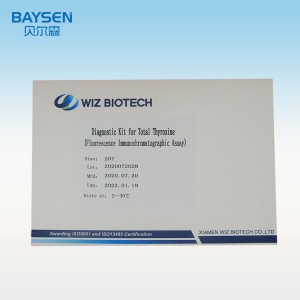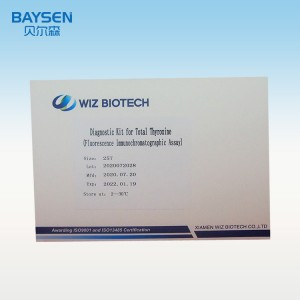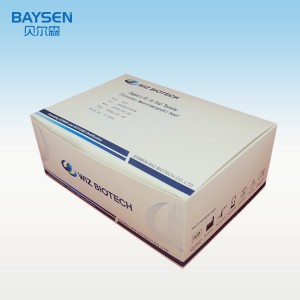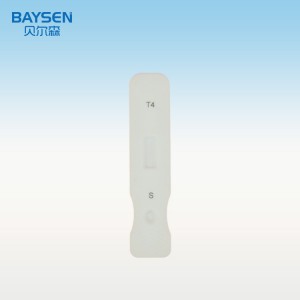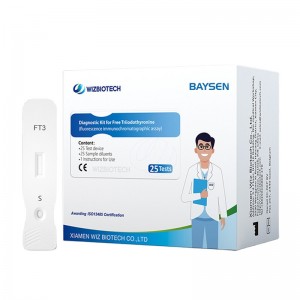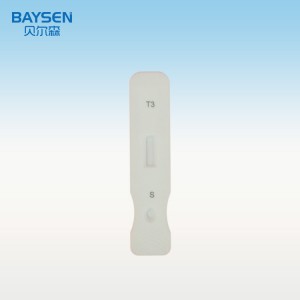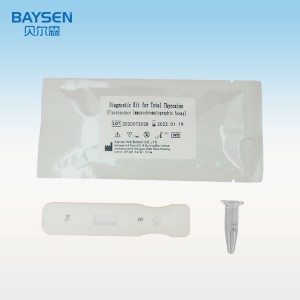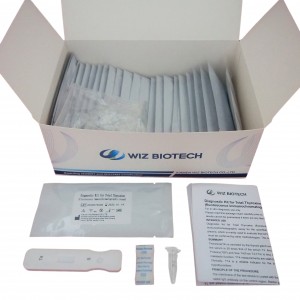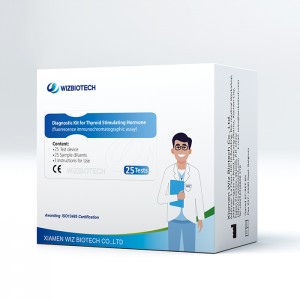Diagnostic Kit for Total Thyroxine (fluorescence immunochromatographic assay)
Diagnostic Kit for Total Thyroxine (fluorescence immunochromatographic assay)
For in vitro diagnostic use only
Please read this package insert carefully prior to use and strictly follow the instructions. Reliability of assay results cannot be guaranteed if there are any deviations from the instructions in this package insert.
INTENDED USE
Diagnostic Kit for Total Thyroxine (fluorescence immunochromatographic assay) is a fluorescence immunochromatographic assay for the quantitative detection of Total Thyroxine (TT4) in human serum or plasma, which is mainly used to evaluate thyroid function.It is an auxiliary diagnosis reagent.All positive sample must be confirmed by other methodologies. This test is intended for healthcare professional use only.
SUMMARY
Thyroxine(T4) is secreted by the thyroid gland and its molecular weight is 777D. The total T4(Total T4,TT4) in the serum is 50 times that of the serum T3. Among them, 99.9 % of TT4 binds to serum Thyroxine Binding Proteins(TBP),and free T4(Free T4,FT4) is less than 0.05 %. T4 and T3 participate in regulating the body’s metabolic function. TT4 measurements are used to evaluate thyroid functional status and diagnosis of diseases. Clinically, TT4 is a reliable indicator for the diagnosis and efficacy observation of hyperthyroidism and hypothyroidism.
PRINCIPLE OF THE PROCEDURE
The membrane of the test device is coated with the conjugate of BSA and T4 on the test region and goat anti rabbit IgG antibody on the control region. Marker pad are coated by fluorescence mark anti T4 antibody and rabbit IgG in advance. When testing sample, TT4 in sample combine with fluorescence marked anti T4 antibody, and form immune mixture. Under the action of the immunochromatography, the complex flow in the direction of absorbent paper, when complex passed the test region, The free fluorescent marker will be combined with T4 on the membrane.The concentration of TT4 is negative correlation for fluorescence signal, and the concentration of TT4 in sample can be detected by fluorescence immunoassay assay.
REAGENTS AND MATERIALS SUPPLIED
25T package components:
.Test card individually foil pouched with a desiccant 25T
.A solution 25T
.B solution 1
.Package insert 1
MATERIALS REQUIRED BUT NOT PROVIDED
Sample collection container,timer
SAMPLE COLLECTION AND STORAGE
1.The samples tested can be serum, heparin anticoagulant plasma or EDTA anticoagulant plasma.
2.According to standard techniques collect sample. Serum or plasma sample can be kept refrigerated at 2-8℃ for 7days and cryopreservation below -15°C for 6 months.
3.All sample avoid freeze-thaw cycles.
ASSAY PROCEDURE
The test procedure of the instrument see the immunoanalyzer manual. The reagent test procedure is as follows
1.Lay aside all reagents and samples to room temperature.
2.Open the Portable Immune Analyzer(WIZ-A101), enter the account password login according to the operation method of the instrument, and enter the detection interface.
3.Scan the dentification code to confirm the test item.
3.Take out the test card from the foil bag.
4.Insert the test card into the card slot, scan the QR code, and determine the test item.
5.Add 20μL serum or plasma sample to A solution, and mix well.
6.Add 20μL B solution to the above mixture, and mix well.
Leave the mixture for 20 minutes.
Add 80μL mixture to sample well of the card.
Click the “standard test” button,after 10 minutes, the instrument will automatically detect the test card, it can read the results from the display screen of the instrument, and record/print the test results.
Refer to the instruction of Portable Immune Analyzer(WIZ-A101).
EXPECTED VALUES
TT4 normal range:55-140nmol/L
It is recommended that each laboratory establish its own normal range representing its patient population.
TEST RESULTS AND INTERPRETATION
.The above data is the reference interval established for the detection data of this kit, and it is suggested that each laboratory should establish a reference interval for the relevant clinical significance of the population in this region.
.The concentration of TT4 is higher than the reference range, and the physiological changes or stress response should be excluded.Indeed abnormal, should combine clinical symptom diagnosis.
.The results of this method are only applicable to the reference range established by this method, and the results are not directly comparable with other methods.
.Other factors can also cause errors in detection results, including technical reasons, operational errors and other sample factors.
STORAGE AND STABILITY
.The kit is 18 months shelf-life from the date of manufacture. Store the unused kits at 2-30°C. DO NOT FREEZE. Do not use beyond the expiration date.
.Do not open the sealed pouch until you are ready to perform a test, and the single-use test is suggested to be used under the required environment (temperature 2-35℃, humidity 40-90%) within 60 mins as quickly as possible.
.Sample diluent is used immediately after being opened.
WARNINGS AND PRECAUTIONS
.The kit should be sealed and protected against moisture.
.All positive specimens shall be validated by other methodologies.
.All specimens shall be treated as potential pollutant.
.DO NOT use expired reagent.
.DO NOT interchange reagents among kits with different lot no..
.DO NOT reuse test cards and any disposable accessories.
.Misoperation, excessive or little sample can lead to result deviations.
LIMITATION
.As with any assay employing mouse antibodies, the possibility exists for interference by human anti-mouse antibodies (HAMA) in the specimen. Specimens from patients who have received preparations of monoclonal antibodies for diagnosis or therapy may contain HAMA. Such specimens may cause false positive or false negative results.
.This test result is only for clinical reference, should not serve as the only basis for clinical diagnosis and treatment, the patients clinical management should be comprehensive consideration combined with its symptoms, medical history, other laboratory examination, treatment response, epidemiology and other information.
.This reagent is only used for serum and plasma tests. It may not obtain accurate result when used for other samples such as saliva and urine and etc.
PERFORMANCE CHARACTERISTICS
| Linearity | 20nmol/L to 320nmol/L | relative deviation:-15% to +15%. |
| Linear correlation coefficient:(r)≥0.9900 | ||
| Accuracy | The recovery rate shall be within 85% – 115%. | |
| Repeatability | CV≤15% | |
| Specificity(None of the substances at the interferent tested interfered in the assay) | Interferent | Interferent concentration |
| Hemoglobin | 200μg/mL | |
| transferrin | 100μg/mL | |
| Horseradish Peroxidase | 2000μg/mL | |
| rT3 | 100ng/mL | |
| T3 | 500ng/mL | |
REFERENCES
1.Hansen JH,et al.HAMA Interference with Murine Monoclonal Antibody-Based Immunoassays[J].J of Clin Immunoassay,1993,16:294-299.
2.Levinson SS.The Nature of Heterophilic Antibodies and the Role in Immunoassay Interference[J].J of Clin Immunoassay,1992,15:108-114.
Key to symbols used:
 |
In Vitro Diagnostic Medical Device |
 |
Manufacturer |
 |
Store at 2-30℃ |
 |
Expiration Date |
 |
Do Not Reuse |
 |
CAUTION |
 |
Consult Instructions For Use |
Xiamen Wiz Biotech CO.,LTD
Address:3-4 Floor,NO.16 Building,Bio-medical Workshop,2030 Wengjiao West Road,Haicang District,361026,Xiamen,China
Tel:+86-592-6808278
Fax:+86-592-6808279








